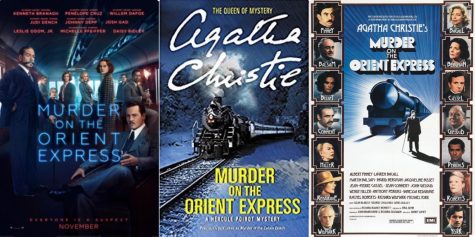Murder on the Orient Express Movie Review
 “The book is a film that takes place in the mind of the reader. That’s why we go to movies and say, ‘Oh, the book is better.’” -Paulo Coehlo
“The book is a film that takes place in the mind of the reader. That’s why we go to movies and say, ‘Oh, the book is better.’” -Paulo Coehlo
One of the most difficult parts of adapting a book to the big screen is the fact that a director must decide how they wish to portray and build upon the source material and characters they are given. Some films adhere strictly to their original blueprint, picking the best scenes from a book to portray, while others are more adventurous, giving a new spin to old stories. However, whichever approach is taken in crafting a film, there is one insurmountable challenge in making movies based on best-selling books: their audience. Every reader has a different mental picture of a story when they read a novel, their imagination conjuring personal visions of characters, settings, and important moments in the plot that are vastly different from any other person reading those same words. However, book adaptations still prove immensely profitable for the studios that create them, and occasionally classic novels find themselves becoming the source material for several different appearances on the big screen.
In 2017, Murder on the Orient Express has shown itself to be one of those powerhouse stories, with this new film actually being the second version of Agatha Christie’s famed detective novel to hit theaters, following Sidney Lumet’s 1974 creation. Both movies are based on Christie’s novel of the same name, one of a series of books written about her fabled hero, Hercules Poirot, the Belgian Sherlock Holmes who solves some of the most difficult cases in the world. While returning home on the Simplon-Orient Express from a case in the Middle East, Poirot finds himself caught in the middle of one of the most puzzling murders of his careers that tests all his skills of deduction. The novel is widely acclaimed and universally enjoyed, and as such, it has found a place among other literary gems on Benet’s Freshman Reading List, allowing Benet’s new students a chance to enjoy both Christie’s wonderful writing and two well-crafted and entertaining films.
1974’s version of the story starred some of the most talented actors and actresses of its decade, including Albert Finney, Lauren Bacall, and Ingrid Bergman. Both Finney and Bergman were nominated for Oscars for their roles in the film, with Bergman going on to win Best Supporting Actress for her portrayal of maid Greta Ohlsson. The Murder on the Orient Express of 1974 capitalizes on the all-star line-up it had access to in creating the film, crafting scenes that featured powerful, realistic, and entertaining dialogue and character interactions. Sidney Lumet’s greatest achievement lies in his ability to capture so many of the layered and complex relationships Christie weaved between her characters in the novel, with the film being able to successfully convey great chemistry among its actors in its two-hour runtime. However, the film’s length forced the creative to pick and choose only what parts of the story they deemed essential, leaving some characters and elements of the plot on the cutting room floor so as to keep the final product trim and easily understood by the general public. Still, Lumet’s creation masterfully imitates the atmosphere of the original novel in his film’s elegance, mystery, and power, making 1974’s Murder on the Orient Express a great watch for any interested reader or theatergoer.
Kenneth Branagh’s 2017 spin on the novel also featured a stellar cast from among the industry’s top actors and actresses, including Johnny Depp, Josh Gad, and Daisy Ridley. However, this Murder on the Orient Express went a different route than its predecessor. Having access to newer technology and better effects than were available in 1974, Branagh made sure to spare no expenses when it came to shooting his film. The cinematography for this Murder on the Orient Express is beautiful and breathtaking, from perfectly rendered views of sprawling natural and urban settings to keen attention to color and depth in post-production. Not only is the film wonderfully edited, but it also plays with the camera’s position in inventive ways that add a new perspective to scenes that give scenes that previously could have been mundane and artistic tint. 2017’s version offering finds its major fault in the fact that it too had to make creative choices in what scenes from Agatha Christie’s original novel to bring to the big screen, a difficult process with such an intricate and well-done book and only two hours to tell its story. However, Branagh’s Murder on the Orient Express did make the skillful decision to take the audience back to Poirot’s previous case before boarding his ill-fated train, a helpful addition that introduced Poirot’s character with little exposition. However, such insertions ate into other character’s development and screen-time, which left some of them under-developed and this film lacking the kind of chemistry that characterizes 1974’s version. Branagh also took liberties in portraying scenes from the original novel, adding new details and action sequences to the plot that were intended to cater to today’s audience but could upset some fans of the old story as they see it updated. Despite its shortcomings, 2017’s Murder on the Orient Express is still immensely entertaining, gripping, and above all enjoyable for viewers.
In sum, both 1974’s and 2017’s version of Murder on the Orient Express are excellent films, each bringing a new perspective to Christie’s novel and a skillful interpretation of this story. Both these movies and the book on which they are based provide a wonderful escape for their audience though, transporting them to a world of snow, murder, revenge, and mystery, all while on the luxurious Orient Express.





